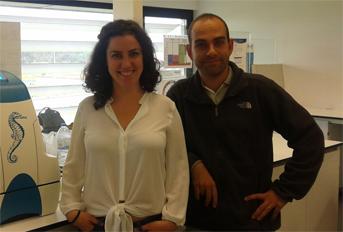Associação Portuguesa de Investigação em Cancro
Betulinic acid derivative compounds disturb mitochondria of breast cancer cells and induce cell death
Betulinic acid derivative compounds disturb mitochondria of breast cancer cells and induce cell death

The cell death is regulated by mitochondria. For high concentrations, betulinic acid disrupts mitochondrial function leading cancer cells to death. Therefore, in the present work, we have altered the main structure of betulinic acid in order to increase the efficacy to kill tumor cells. The new molecules promote the death of breast cancer cells, which showed to be not toxic to normal counterparts.
Authors and Affiliations:
Teresa L. Serafim1, Filipa S. Carvalho1, Telma C. Bernardo1, Gonçalo C. Pereira1, Edward Perkins2, Jon Holy3, Dmytro A. Krasutsky4, Oksana N. Kolomitsyna4, Pavel A. Krasutsky4, Paulo J. Oliveira1.
1 CNC, Center for Neuroscience and Cellular Biology, Department of Life Sciences, University of Coimbra, Coimbra, Portugal;
2 Mercer University School of Medicine, Savannah, Georgia, USA;
3 Department of Biomedical Sciences, University of Minnesota Medical School, Duluth, Minnesota, USA;
4 Natural Resources Research Institute, University of Minnesota-Duluth, Minnesota, USA.
Abstract:
Novel cationic dimethylaminopyridine derivatives of pentacyclic triterpenes were previously described to promote mitochondrial depolarization and cell death in breast and melanoma cell lines. The objective of this work was to further investigate in detail the mechanism of mitochondrial perturbations, correlating those effects with breast cancer cell responses to those same agents. Initially, a panel of tumor and non-tumor cell lines was grown in high-glucose or glucose-free glutamine-containing media, the later forcing cells to synthesize ATP by oxidative phosphorylation only. Cell proliferation, cell cycle, cell death and mitochondrial membrane polarization were evaluated. Inhibition of cell proliferation was observed, accompanied by an arrest in the G1-cell cycle phase, and importantly, by loss of mitochondrial membrane potential. On a later time-point, caspase-9 and 3 activation were observed, resulting in cell death. For the majority of test compounds, we determined that cell toxicity was augmented in the galactose media. To investigate direct evidences on mitochondria isolated rat liver mitochondria were used. The results showed that the compounds were strong inducers of the permeability transition pore. Confirming our previous results, this work shows that the novel DMAP derivatives strongly interact with mitochondria, resulting in pro-apoptotic signaling and cell death.
Journal: Bioorganic & Medicinal Chemistry
Link: http://www.sciencedirect.com/science/article/pii/S0968089614005902




